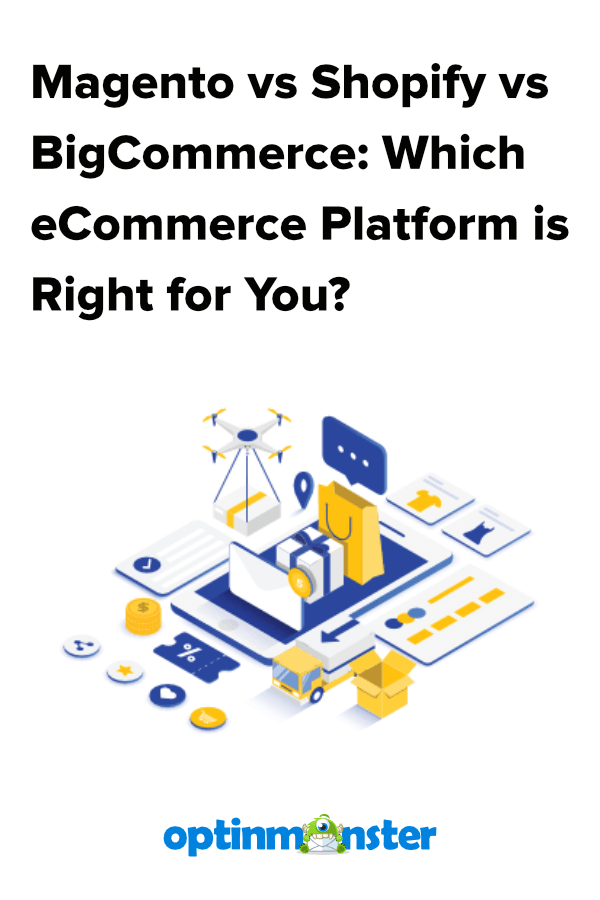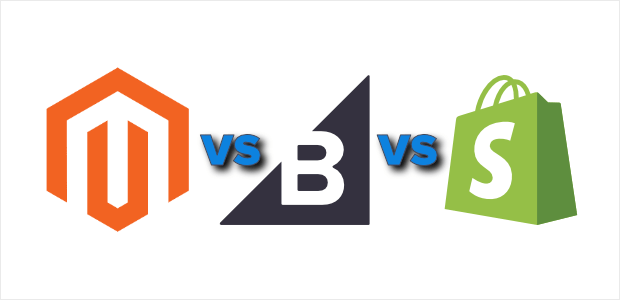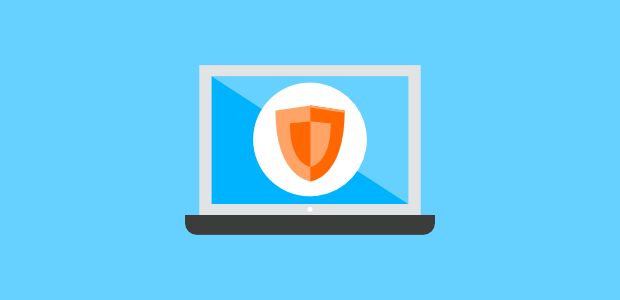Whether your business is small and looking to grow fast or a huge enterprise exploring new options, choosing the right eCommerce platform for your eCommerce store is not a decision to be taken lightly.
As you’re researching options, some big names are no doubt popping up, particularly Magento, Shopify, and BigCommerce.
To help you make this important decision, we’ve put together a side-by-side comparison of these 3 major players in the game. Not only do they control a large percent of the market share, but they’re also showing some interesting innovations as they adapt to a changing eCommerce landscape.
Keep reading to find out what sets these eCommerce giants apart and which may be the best eCommerce platform for you.
Summary: Magento vs Shopify vs BigCommerce
Magento started out as open-source software and has typically been used by larger businesses since a lot of development effort is needed to harness its real functionality, and that takes a big budget.
Magento does offer on-site and cloud-hosted options, but what about SaaS (software-as-a-service)? Many businesses are interested in SaaS eCommerce solutions because they provide continuous updates, including security patches.
Shopify and BigCommerce are leaders in the SaaS eCommerce space. Both are easy to use, include tons of features, and can help your business get up and running quickly.
Businesses that are totally new to eCommerce may choose to start with Shopify stores, but more established businesses and businesses looking to grow often choose BigCommerce for its extensibility and flexibility.
| BigCommerce | Shopify | Magento | |
|---|---|---|---|
| Pricing | Affordable | Affordable | Expensive |
| Ease of Use | Easy | Easy | Complex |
| Template Selection | Hundreds | Hundreds | None on-site |
| Hosting | Cloud-based | Cloud-based | On-site, 3rd-party, Cloud-based |
| Security | Highly secure | Secure | Depends on your standards |
| Features | Feature-rich | Some native features, 3rd-party apps | Feature-rich |
| Best for: | Small and large shops that want a streamlined eCommerce experience | Small shops wanting to go online | Huge teams, with lots of resources |
Breakdown: Magento vs Shopify vs BigCommerce
We provided a summary of each eCommerce platform above, but now it’s time to get into the nitty-gritty details so you have the information you need to make the right decision.
Pricing
Your budget for an eCommerce platform will probably help narrow down your choices since some platforms are a lot pricier than others. When trying to decide, make sure to factor in all of the costs, not just the initial costs to get set up. Ongoing costs include things like maintenance, security, and hosting.
1. Magento: expensive
The cost to license Magento software depends on which product you use. Magento Open Source (formerly Community Edition) is technically free to download from Magento’s website; however, you’ll have to cover all hosting, security, development, and design fees. Additionally, this option doesn’t come with any support.
Magento Enterprise Edition does have a support package but is significantly more expensive. Your quote will depend on the size and complexity of your business, with annual pricing ranging from $22,000 to $125,000.
Magento also offers the cloud-hosted Magento Cloud Edition. It has a Platform-as-a-Service (PaaS) model which has some but not all of the advantages of a SaaS (Software-as-a-Service) platform. For more information on the difference between PaaS and SaaS, check out this comparison of the platforms. The Cloud Edition is more expensive still with sources saying it can range from $40,000 to $125,000 annually.
2. Shopify: affordable
Shopify also has a number of pricing models depending on business complexity, but a Basic Shopify Plan starts at $29 and has the fewest features. More advanced plans range from $79-$299 a month. Shopify Plus, designed for larger businesses, starts at around $2000 a month.
Shopify’s lack of some basic native features can drive up your total cost of ownership, so make sure to think about the added features you will need and to factor those into the total cost.
3. BigCommerce: affordable
BigCommerce is another affordable eCommerce solution to consider and has a number of options for different price points. The most basic plan, BigCommerce Essentials, starts at $29.00 per month, with more advanced plans at $79 and $249. Enterprise plans with extensive native features are available with competitive prices dependent on business size and complexity.
Ease of Use
Another important factor is how easy the platform is for your teams to use. You and your team need to be able to quickly ramp up, understand how to use the platform’s features, and make full use of them. Depending on your business size and structure, you likely want an eCommerce platform that is both easy to use on the backend and easy for marketing teams to make changes on the frontend.
1. Magento: highly complex
Magento does not come with training wheels. They don’t provide on-site developers to help with building your site. You’ll need to either a developer or a team of developers to build your site, find a hosting partner that can host your site, AND get someone to integrate your tech stack.
Even after set up, Magento has a steep learning curve. Its flexibility can also be a liability for newer users who can’t navigate its complexity without considerable difficulty.
2. Shopify: intuitive
Shopify was built to satisfy the needs of business owners who want to create an online shop without having a background in development. It has drag and drop tools, making it fairly easy to build a site. Shopify works well for businesses that are new to website building. You can get your website up and running quickly by completing a few simple steps. For more advanced features, you’ll need to add additional apps or use custom coding.
3. BigCommerce: intuitive
BigCommerce makes it easy to build beautiful websites even if you’ve never done it before. Once you’re all set up, BigCommerce is also easy to run through a simple shop page for adding products and managing orders.
Another potential advantage of BigCommerce from a backend user standpoint is its headless offerings. BigCommerce has several pre-built plugins to frontend CMS and DXP systems like WordPress, Bloomreach, Drupal, and more. This means if you’re already using one of these options to run your website, you can connect BigCommerce on the backend and continue using the system you’re already comfortable with on the frontend.
Theme Selection
After the budget and ease of use concerns, one of the first things many businesses worry about is how their site will look. The first impression many shoppers have of your online store is the visual elements, and to compete for their attention, you’ll want your store to be a clean, functional, memorable extension of your brand. To this end, choosing the right template or theme for your site is vital to creating the look and feel you want.
1. Magento: none on-site
Magento doesn’t include any themes as part of the native software. They also don’t offer a selection of themes for customers to choose from. Instead, businesses must find and buy their own from 3rd-party sites like Themify or pay a developer to build one.
2. Shopify: hundreds
Shopify offers themes that are either free or available to buy. These themes are mobile-optimized and easily integrated into your shop regardless of what you choose.
3. BigCommerce: hundreds
BigCommerce also has hundreds of fully-customizable templates available, both free or paid. With the help of developers, you can customize all parts of your sites down to the shopping cart.
Hosting
One of the major differences that can separate these platforms from each other is how they are hosted. Will you be hosting the software on-site or will it be hosted through the cloud?
1. Magento: on-premise, 3rd-party, or cloud-based
As we mentioned in the cost section above, there are different Magento products available, so Magento can be hosted on-site, through a 3rd-party, or in the cloud. Magento’s hosting abilities depend on how you use the platform, and because of that, you may be completely responsible for finding a hosting service to use. Magento is a PaaS, not a SaaS, so there isn’t a whole lot they’ll handle on your behalf.
2. Shopify: cloud-based
Shopify is completely cloud-based and hosting is included with your Shopify subscription. That means you won’t have to hunt for 3rd-party hosting and deal with the problems of running it.
3. BigCommerce: cloud-based
BigCommerce also runs off of the cloud and hosting and best-in-class performance are included with your BigCommerce account. You won’t have to struggle to find the right hosting or worry about downtime because BigCommerce has an industry-leading 99.9% uptime.
Security
ECommerce sites can’t afford to be vulnerable to attacks that can compromise customer data and destroy faith in their brand, but eCommerce platforms vary in how much of the burden of security you’ll take on. Based on the size of your team and your own familiarity with security best practices, you can make a decision of how much of the burden you’re willing to shoulder.
1. Magento: dependent on your standards
Magento is as secure as your developers want to make it. Even for simple things like SSL, you’ll have to take care of certification and upkeep. Magento will create patches for known security risks (like the SQL site injection vulnerability that left 300,000 Magento stores at risk in 2019); however, it’s up to your team to keep your site up to date.
2. Shopify: secure
One of the advantages of a SaaS solution is that security is included. Shopify meets all 6 categories of PCI standards and includes SSL security on their hosted sites.
3. BigCommerce: highly secure
As a SaaS offering, BigCommerce also provides multiple layers of strong security for all sites they host. BigCommerce has sitewide SSL security, DDOS protection, 99.9% uptime, blazing-fast speed, and is level PCI-1 compliant. This lets business owners focus on innovation and growing their business and less on security and performance.
Features
All businesses have different needs and priorities when it comes to the features you look for in an eCommerce platform. If you’re a B2B seller, you might need options for different customer groups or, depending on your industry you might need to offer multiple payment gateways and shipping options to keep up with competitors. We can’t get into a full list of all the available features for these platforms here, but here’s a quick rundown.
1. Magento: feature-rich
Magento has a wide selection of features list support for large product catalogs with lots of variants, native product bundles and groups, and cross-selling and upselling features. Users also have access to extensions and addons. When considering Magento, you can customize your eCommerce website with almost whatever you need, but you’ll probably need to find developers able to make it happen and then maintain it.
2. Shopify: some native features
Shopify has some native features as well, and other functionality can be achieved through Shopify 3rd-party apps. Think about the features you’ll need and add up the costs of the apps necessary to do what you want… This could have a big impact on the total cost of the platform. Also, Shopify does charge transaction fees for not using their payment gateway (Shopify Payments), so take that into consideration, too.
3. BigCommerce: feature-rich
BigCommerce offers an extensive number of native features that can ultimately lead to cost savings since you won’t be relying on as many 3rd-party apps. Helpful features on BigCommerce include a channel manager to make omnichannel selling simpler, abandoned cart saver, and a wide selection of payment gateways.
Magento vs Shopify vs BigCommerce: Which eCommerce Platform Is the Best?
There’s no one-size-fits-all eCommerce platform, although some work for a larger number of use cases than others. The key is finding the platform that’s not only the right fit for you now but that your business can grow into. You don’t want to hitch your brand’s wagon to a platform that ends up limiting your growth; you need one that will grow with you as you continue to grow.
1. Magento: best for big teams, with lots of resources
If you’re a well-established business that has a large budget to devote to eCommerce and a lot of developer resources to put toward site set-up and maintenance, then Magento might be the right choice for you. Magento can provide opportunities to customize your eCommerce site to your exact specifications, provided you have a team of developers to work on the project. Keep in mind that there are a limited number of qualified Magento developers out there, so make sure you have some who have the bandwidth to complete your project.
You may also be interested in checking out this post on Magento extensions that boost conversions and sales.
2. Shopify: best for small shops wanting to get online
New to eCommerce? Shopify offers great features for those that don’t have much experience building online stores. It’s a good fit for businesses that just want to take their small business online and get it up and running.
Related Content10 Best Shopify Alternatives (In-Depth Comparison)
3. BigCommerce: best for both small and large shops
BigCommerce is a great fit for businesses of all sizes and particularly those who are looking to grow. It offers impressive eCommerce features, best-in-class uptime, and robust security. BigCommerce can handle not only small stores, but large stores with many SKUs, so it can grow with your business. And, because of the BigCommerce platform’s integrations, flexible APIs, and webhooks, it can provide endless opportunities for customization while leveraging your existing tech stack.
There’s no shortage of eCommerce platforms to choose from, but it’s no secret that Magento, Shopify, and BigCommerce are some of the biggest names in the business. Hopefully, this guide has helped you understand a few of their key differences and decide which might be the right fit for your business.
If you’re going with BigCommerce, we have a pretty awesome list of BigCommerce apps to help you increase sales.
Already work with BigCommerce? You may also like this one on how to create a BigCommerce popup to boost sales.
Have you found the right eCommerce platform? Looking for a change? Let us know in the comments!
And, no matter which eCommerce platform you choose, remember that OptinMonster is always with you to help you increase subscribers, convert more leads, and boost sales. Get started with OptinMonster today!














Add a Comment